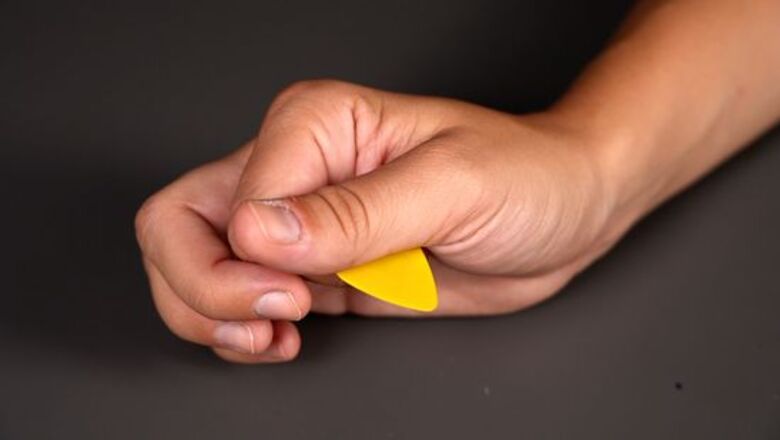
views
- Hold a guitar pick (or "plectrum") between your thumb and index finger. Grasp it firmly enough to strike the strings, but not so firmly that it can’t bend.
- Choose a grip that works for you—either hold it between the pads of your thumb and pointer finger or hold it between the side of your index finger and thumb.
- Grip the pick near the middle to get the most control without sacrificing flexibility.
Common Picking Grips
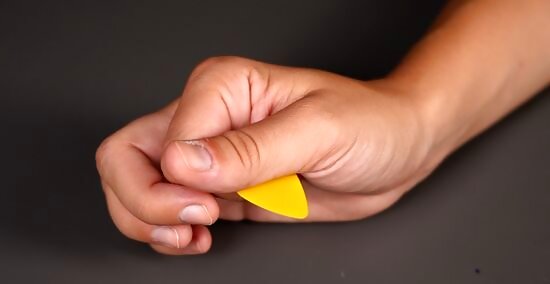
Pad to side Hold the pick between the pad of your thumb and the side of the tip of your index finger, then form your fingers into an elongated "O" shape. This is the most common way to hold a pick.
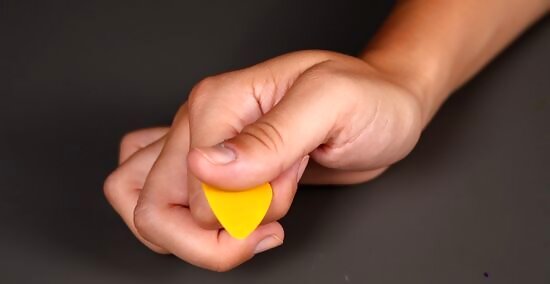
Far knuckle Press the pick between the pad of your thumb and the second joint of your pointer finger (the one that lets the fingertip bend). This grip helps steady your index finger against the pressure of your thumb. Another version of this grip is the “middle knuckle”, where you hold the pick against the first joint instead of the second. You can’t play as quickly with this grip, but it gives you a lot of control.
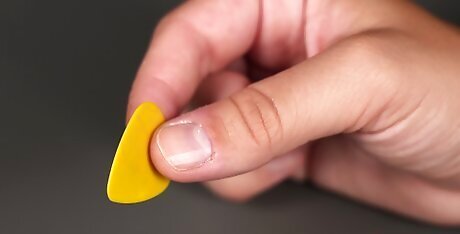
Pad to pad For this grip, hold the pick between the pad of your index finger and thumb. Since your fingers are extended in this grip, the movement between strings needs to come from your wrist and not your hand. It’s good practice, since real speed comes from the wrist. You can also use your middle finger instead of the index. It will feel a little more awkward when you start, but it works for some people.
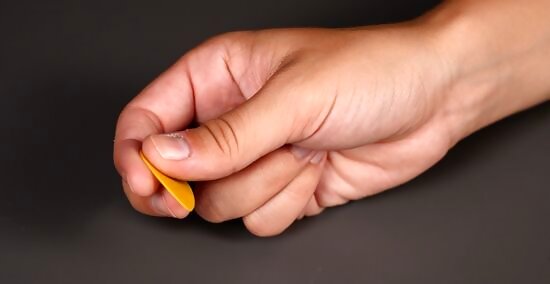
Three finger This is like the pad to pad method, but instead of using only your pointer or middle finger, you use both. This is another stiff position (one that requires you to use your wrist more than your fingers) but it allows you to angle the pick more easily.
Using a Pick
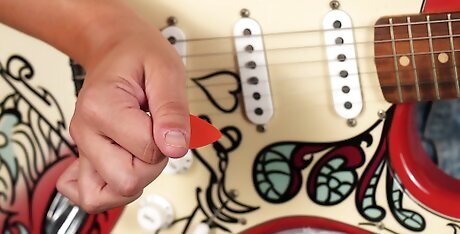
Grasp the pick in your strumming hand. Most people are most comfortable strumming and plucking a guitar with their dominant hand, while fingering specific notes and chords with their non-dominant hand.
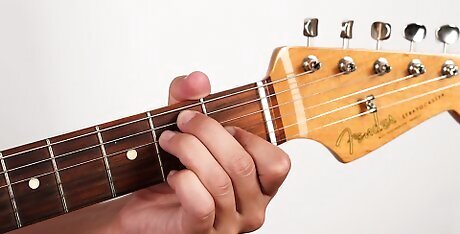
Place your non-dominant "fingering hand" along the neck of the guitar. Hold the back of the neck with your thumb and rest your fingers on the strings. The strings should face away from you, roughly perpendicular to the ground. Rest the body of the guitar on your knee, or use a shoulder strap to play standing up.

Rest your arm on the top of the guitar. Lay your arm on the curved ridge along the narrowest edge of the body and swing your hand down to rest on the strings. If you're using an acoustic guitar, rest your fingers on the strings over the hold; if you're using an electric guitar, rest your fingers on the strings between the last fret and the pickup bar.
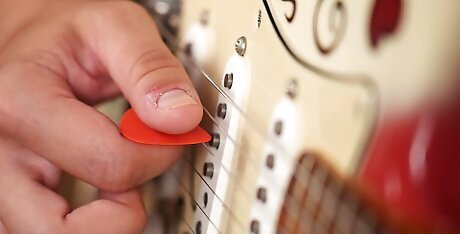
Hold your pick firmly, but loose enough that it can bend. Cover roughly half of the pick with your fingers--some picks are molded with a groove to indicate where your thumb and forefinger should fit. Use a firm grip, but loose enough that you can allow the tip of the pick to bend. Don't hold the pick too loosely, or it might fly out of your hand.
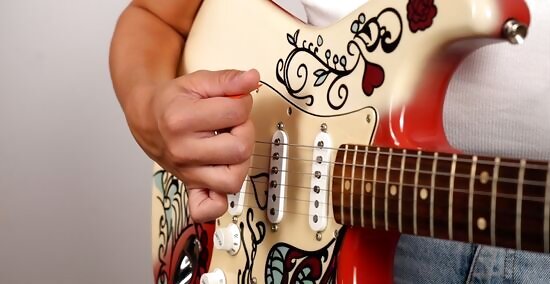
Pivot your wrist toward your guitar. The flat tip of your pick should gently rest on a string, and the long side of the pick should be as perpendicular to the string as possible. The angle of your wrist is essential to the picking process: when playing guitar, you are not really picking with your fingers, but your wrist. Flick your wrist up and down to strum and pick.
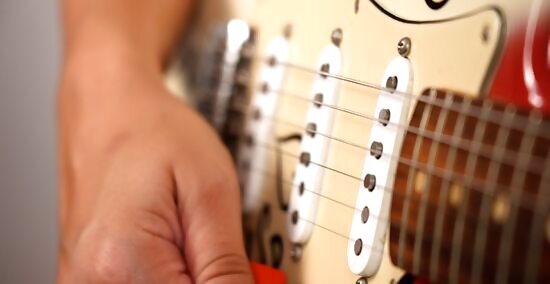
Brush the strings at a slight angle. Use the pick to brush the surface of the strings: not so gently that the sound is weak, but not so firmly that you're catching the string on the pick. As you go over the strings, angle the pick slightly. Angle it up when you’re strumming down, and down when you’re strumming up. Be loose and flexible with all of your motions. If you’re too rigid, your picking will sound harsh and off rhythm.
Picking Techniques
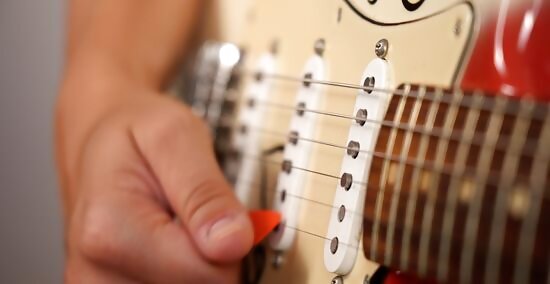
Strum your guitar with a loose wrist and elbow. Strums are full, multi-string sounds that form an integral part of most guitar rhythms. Rest the tip of the pick gently atop the thickest, uppermost string (usually tuned to E). Brush the tip of the pick along the strings, from thickest to thinnest, and make sure to hit every string along the way. Strum quickly to blur the notes together, and slowly to enunciate each tone; strum gently for a quieter chord, and apply more pressure for a louder sound. You can strum up-down (high, thin strings to low, thick strings) or down-up (low, thick strings to high, thin). You can also strum any section of strings, say, 2-4, or open G to open E. Try holding certain strings to form chords when you strum. Make sure to hold down strings tightly when you finger notes and chords.
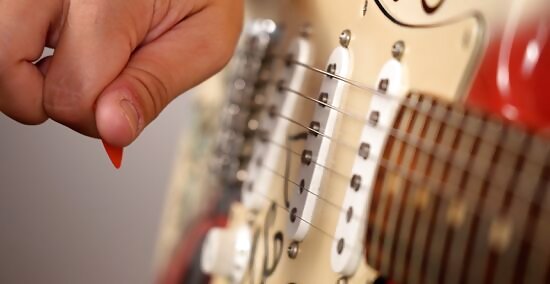
Pluck your guitar. Some songs require you to pluck one string at a time. Rest the tip of your pick on the string as if you were strumming, but only hit the single string. Strike the string with the pick, then pull it away from the neck of the guitar to not hit any other strings. You can keep a chord formed with your non-dominant hand on the neck of the guitar, then pick a single note—or several notes in succession—from that chord.
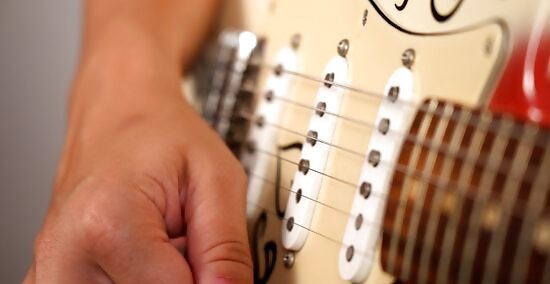
Alternate picking up and down to gain speed, precision, and accuracy. As with strumming, you can pluck upward or downward. Try to create a flow between strokes: pluck down, strum up, strum down, pluck up. Make your playing efficient--it takes more time to strum down twice (returning up in between) than to strum down and then back up.
Choosing a Pick
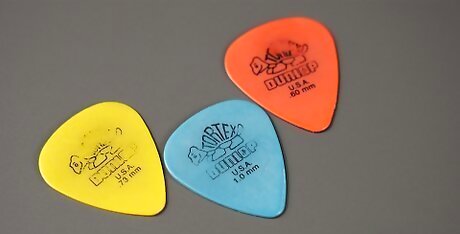
Pick your thickness based on the sound you want. Most brands of pick are sold by thickness: they are often labeled "thin", "medium", or "thick", accompanied by a millimeter measurement. Most plastic guitar picks are available in sizes ranging anywhere from 0.4 millimeters (mm) to 3 mm. Try starting out with a medium pick, between 0.60 and 0.80 millimeters thick. Thin picks usually range from 0.40 to 0.60 mm. They are best-suited for acoustic strumming, and whenever you want a treble-heavy tone, but they lack the heft for rock rhythm and lead. Medium picks range from 0.60 to 0.80 mm. This is the most popular pick thickness: it's a good combination of stiffness and flexibility that works equally well for acoustic rhythms and powerful leads. Heavier picks--really, anything thicker than 0.80 mm--generate a heavier sound. At the lower end of this range, you’ll still have enough flexibility for crunchy rhythms, but you’ll also have the firmness you need for full-bodied chord arpeggios and fat lead lines. At the thicker end of this range, above 1.5 mm, you'll get increasingly cleaner, mellower, warmer tones.
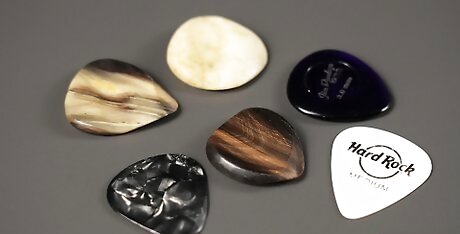
Consider pick materials. Different materials will produce different sounds. Most cheap guitar picks are made from plastic and work fine for pinning down the basics. Once you get into specific playing styles, start trying new materials. Use a metal pick for a higher-pitched sound, or a rubber pick for a thicker, heavier sound. Don't worry if you wear down the edges of a plastic pick; just get another. If you aren't sure, try out a few styles of pick before you commit. You can find guitar picks at most music stores, certain music-culture boutiques, and online.
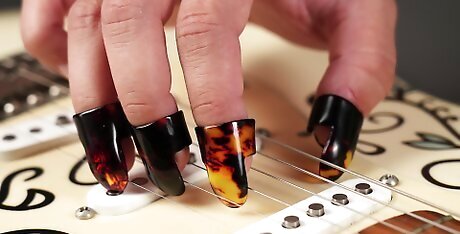
Use specialized picks for certain instruments. You don't use traditional guitar picks to play the banjo—instead you use special finger-picks that clip to your fingertips to facilitate plucking. In general, banjo finger-picks slip over the tips of your index, middle, and ring fingers, with a sharp fingernail-like "pick" curving backward from the pad of your finger over your fingernail. If you're using banjo finger-picks, consider visiting a banjo technique website or asking around at a music store.
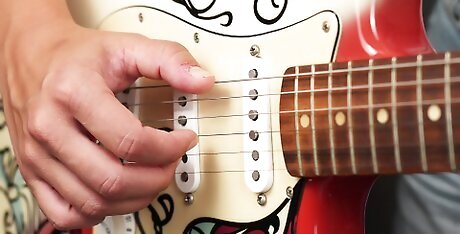
Consider learning to pick with your bare fingers. With finger-picking, your thumb plays the three bass strings and your fingers play the three treble. Use the pads of your fingers to pick upward (high strings to low), and use the nails of your fingers to pick down (low strings to high). Use several fingers to strum for a fuller sound. Finger picking can greatly improve speed when playing complex melodies. If you switch over to finger-picking after using a pick, it may take you anywhere from a few weeks to a few months to regain the level of dexterity that you're used to. If you are committed to learning to finger-pick, only practice with your fingers and not with a pick. When you become quicker and more confident in your finger-picking practice, try plucking two strings at once--or even three. Use your fingers to develop complex melodies.












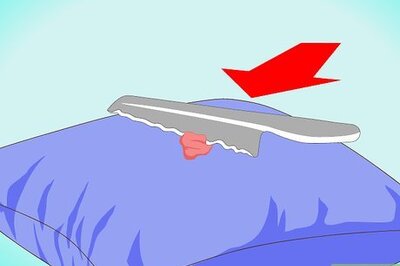

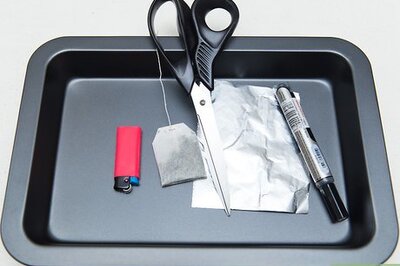





Comments
0 comment